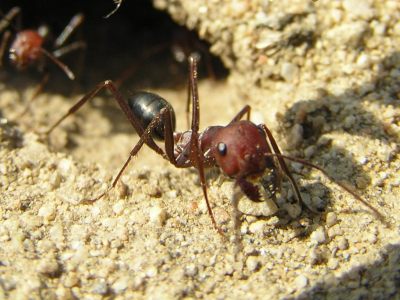|
|

|
|
bees & wasps
|
|
|
______________________________________________________________________
ANTS
Legakis (1985) was unable to include Thásos in his biogeographical analysis
of the ant fauna of the Greek islands as insufficient information was available.
However, the fauna can be expected to be rich, perhaps in the region of 70
species or more given that Collingwood (1993) was able to find 41 species on
Karpathos in a brief visit and Agosti & Collingwood (1987a) report 161
species from northern Greece. As a contribution to the study of ant biogeography
in the Aegean I have collected ants for Cedric Collingwood during my visits and
from this material he has identified 29 taxa. Of these, Tetramorium splendens,
Camponotus atricolor and C. oertzeni are not listed by Agosti &
Collingwood (1987a) as having been recorded from Greece, whilst Myrmica
bessarabica, Tetramorium cf. punctatum, Lepisiota bipartita, L. frauenfeldi
(=caucasica)
and Lasius citrinus are not reported by these authors from the Balkan region.
 The
taxonomy and identification of ant species is beset with problems and, although there has been considerable progress towards
standardisation of nomenclature (Bolton, 1994), it is evident that the knowledge
of the Greek fauna requires substantial revision. Borowiec & Salata (2012) have
corrected and updated the preliminary checklist of Legakis (2011) but they have
not incorporated the above records from Thasos. Numerous keys to identification
exist for different parts of Europe but Agosti & Collingwood (1987b) provide
the most comprehensive keys to the worker caste of ants on the Aegean islands. The
taxonomy and identification of ant species is beset with problems and, although there has been considerable progress towards
standardisation of nomenclature (Bolton, 1994), it is evident that the knowledge
of the Greek fauna requires substantial revision. Borowiec & Salata (2012) have
corrected and updated the preliminary checklist of Legakis (2011) but they have
not incorporated the above records from Thasos. Numerous keys to identification
exist for different parts of Europe but Agosti & Collingwood (1987b) provide
the most comprehensive keys to the worker caste of ants on the Aegean islands.
Most
ant species on Thásos are inconspicuous and require specialist survey to locate
them, however a few species cannot fail to be noticed by visitors. Cataglyphis
nodus is a large red and black ant that nests in sandy soils on tracksides
and in coastal olive groves. The workers are very active during the heat of the
day and run quickly in zig-zag paths with their dark abdomens (gaster) held at
an angle above their bodies. The harvester ants Messor spp. are widely
distributed on Thásos and are remarkable for their large flat nests composed
almost entirely of seed husks. M. muticus and M. wasmanni appear
to be the commonest of these large shiny black ants but M. orientalis
also occurs.
CHECKLIST
(nomenclature
follows Agosti & Collingwood 1987a, although some sub-specific taxa have now
been allocated specific status, and incorporates revisions included in Bolton
1994. This checklist has not been updated with regard to Borowiec & Salata 2012)
Myrmicinae
Pheidole pallidula
(Nylander)
Myrmica
bessarabica Nasarov
Aphaenogaster
subterraneoides Emery
Messor muticus
Nylander
Messor orientalis
(Emery)
Messor wasmanni
Krausse
Crematogaster
schmidti (Mayr)
Solenopsis
sp.
1
Leptothorax
affinis Mayr
Leptothorax
exilis Emery
Leptothorax
rougeti Bondroit
Leptothorax
semiruber
Andre
Leptothorax
unifasciatus
(Latreille)
Tetramorium
?punctatum Santschi
Tetramorium
splendens
Ruzsky
Formicinae
Plagiolepis
pygmaea (Latreille)
Plagiolepis
vindobonensis
Lomnicki
Lasius alienus
(Foerster)
Lasius
citrinus Emery
Camponotus
aethiops (Latreille)
Camponotus
atricolor
(Nylander)
Camponotus
concavus Dalla Torre
Camponotus
creticus Forel
Camponotus
oertzeni Forel
Camponotus piceus
(Leach)
Cataglyphis nodus
(Brulle)
Formica
cunicularia
Latreille
Lepisiota
bipartita
(Smith)
Lepisiota frauenfeldi (Mayr)
REFERENCES
Agosti, D. &
Collingwood, C.A. 1987a. A provisional list of the Balkan ants (Hym., Formicidae)
and a key to the worker caste. I. Synonomic list. Bulletin de la Societé
Entomologique Suisse, 60: 51-62
Agosti, D. &
Collingwood, C.A. 1987b. A provisional list of the Balkan ants (Hym., Formicidae)
and a key to the worker caste. II. Key to the worker caste, including the
European species without the Iberian. Bulletin de la Societé Entomologique
Suisse, 60: 261-293
Bolton, B. 1994. Identification
guide to ant genera of the world. Harvard University Press.
Borowiec, L. & Salata, S. 2012. Ants of
Greece – checklist, comments and new faunistic data (Hymenoptera: Formicidae).
Genus, 23: 461-563.
Collingwood, C.A.
1993. A comparative study of the ant fauna of five Greek islands.
Biologia Gallo-Hellenica, 20: 191-197
Langourov, M.S., Simov, N.P. & Abadjiev, S.P. 2013. Chilades
trochylus (Freyer, [1845]) (Lep.: Lycaenidae), new for the North Aegean
Islands. Entomologist's Record and Journal of Variation, 125:
137-143.
Legakis, A. 1985.
Contribution to the zoogeography of ants (Hymenoptera, Formicidae) in the Greek
islands. Biologia Gallo-Hellenica, 10: 253-257.
Legakis A.
2011. Annotated list of the ants (Hymenoptera, Formicidae) of
Greece. Hellenic Zoological Archives 7:1-55.
|


 The
taxonomy and identification of ant species is beset with problems and, although there has been considerable progress towards
standardisation of nomenclature (Bolton, 1994), it is evident that the knowledge
of the Greek fauna requires substantial revision. Borowiec & Salata (2012) have
corrected and updated the preliminary checklist of Legakis (2011) but they have
not incorporated the above records from Thasos. Numerous keys to identification
exist for different parts of Europe but Agosti & Collingwood (1987b) provide
the most comprehensive keys to the worker caste of ants on the Aegean islands.
The
taxonomy and identification of ant species is beset with problems and, although there has been considerable progress towards
standardisation of nomenclature (Bolton, 1994), it is evident that the knowledge
of the Greek fauna requires substantial revision. Borowiec & Salata (2012) have
corrected and updated the preliminary checklist of Legakis (2011) but they have
not incorporated the above records from Thasos. Numerous keys to identification
exist for different parts of Europe but Agosti & Collingwood (1987b) provide
the most comprehensive keys to the worker caste of ants on the Aegean islands.